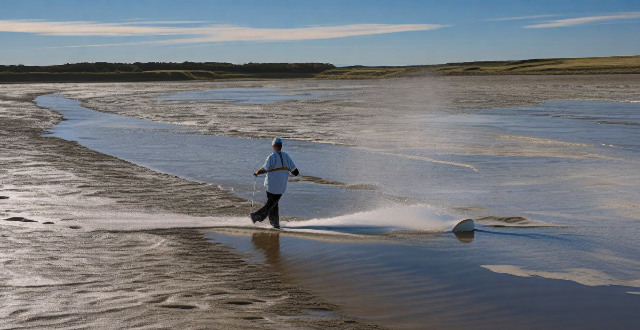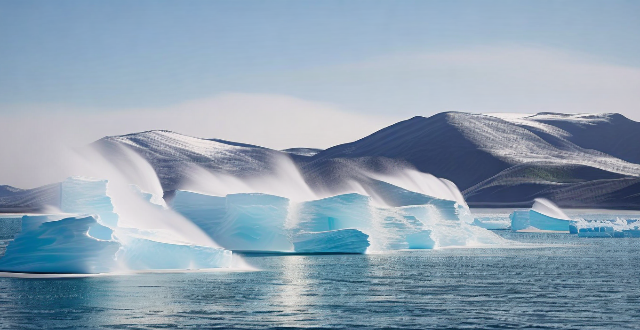Water Drought

What are the most effective strategies for managing water resources during droughts ?
Effective strategies for managing water resources during droughts include rainwater harvesting, water conservation, reusing wastewater, and public awareness campaigns. Rainwater harvesting helps reduce dependence on groundwater and surface water sources, while water conservation practices such as fixing leaks and using low-flow fixtures can significantly reduce water consumption. Reusing treated wastewater for non-potable purposes also helps conserve freshwater sources. Public awareness campaigns play a crucial role in educating people about the importance of water conservation and encouraging them to adopt efficient practices and technologies. By adopting these strategies, we can minimize the impact of droughts on people, agriculture, and the environment while ensuring sustainable water management for future generations.

How can climate services be used to manage water resources effectively ?
Climate services play a critical role in water resources management by providing accurate and timely information on weather patterns, climate change, and related phenomena. These services can be used to forecast precipitation, monitor river levels for flood early warning systems, assess the impact of climate change on water availability, plan adaptation measures, monitor drought conditions, manage water quality, and protect ecosystems. By leveraging these services, we can ensure the effective use of water resources, adapt to changing climates, prepare for extreme weather events, and guarantee a sustainable water supply for future generations.

How does ecological design address issues related to water management and consumption ?
Ecological design addresses water management and consumption issues through strategies such as rainwater harvesting, water recycling, using native plants in landscaping, installing efficient water fixtures, permeable paving, smart water management systems, and promoting education on water conservation.

How can we improve water resource management in our community ?
The article discusses the importance of water resource management in our community and suggests various strategies to improve it. These include raising awareness through educational campaigns, implementing water-saving measures like fixing leaks and using low-flow fixtures, upgrading infrastructure such as wastewater treatment plants, promoting sustainable practices like xeriscaping and green roofs, and fostering collaborative efforts among different stakeholders. By adopting these approaches, we can ensure the long-term availability of clean water while protecting the environment.

What changes can I make in my daily routine to use less water ?
Water conservation is a crucial aspect of sustainable living. Here are some practical tips on how to use less water in your daily routine: 1. Shorten your showers by setting a timer or turning off the shower while lathering up. 2. Fix leaks promptly to avoid wasting thousands of gallons of water per year. 3. Optimize laundry and dishwasher usage by only running them when full and choosing appropriate water levels. 4. Turn off the tap while brushing teeth or shaving, using a cup of water instead. 5. Collect rainwater for gardening purposes to reduce reliance on hose water. 6. Install water-saving fixtures and appliances like low-flow toilets, faucets, and high-efficiency washing machines. 7. Adjust lawn care practices by watering early in the morning and considering drought-resistant plants. 8. Reuse water where possible, such as using leftover drinking water for plants or saving unused cooking water for soup stock. 9. Educate yourself and others about water conservation efforts and share your knowledge with family, friends, and neighbors. By making these small changes, you can significantly reduce your water consumption and contribute to a more sustainable future.

How does climate change affect the quality and availability of drinking water ?
This article discusses the various ways in which climate change affects the quality and availability of drinking water, including changes in precipitation patterns, melting glaciers, sea level rise, temperature increase, extreme weather events, and wildfires. It also explores adaptation strategies such as water conservation measures, infrastructure improvements, protection of water sources, and policy and regulation to mitigate these risks and ensure a sustainable water future for all.

What measures can be taken to reduce agricultural water consumption ?
Agriculture is the largest consumer of water worldwide, accounting for approximately 70% of global freshwater withdrawals. Reducing agricultural water consumption is crucial for sustainable water management and food security. Here are some measures that can be taken to achieve this goal: 1. **Improved Irrigation Systems** - Drip irrigation delivers water directly to the root zone of plants, reducing waste through evaporation and runoff. - Sprinkler irrigation uses pipes or hoses to spray water over crops, allowing more precise control than surface methods. - Micro-irrigation includes drip tapes and micro-sprayers, which apply water slowly and directly to plant roots. 2. **Water-Saving Technologies** - Soil moisture sensors help farmers determine when and how much to irrigate based on soil moisture levels. - Weather stations provide data on rainfall, temperature, and humidity, enabling farmers to adjust irrigation schedules accordingly. - Automated control systems allow for real-time adjustments in irrigation based on sensor information. 3. **Efficient Crop Management** - Crop rotation helps maintain soil health and reduces water demand by alternating between high and low water-consuming crops. - Planting cover crops protects soil from erosion and improves its ability to retain moisture. - Intercropping leads to efficient use of resources, including water. 4. **Soil Health Management** - Composting adds organic matter, improving soil structure and making it better at holding water. - Minimal tillage helps maintain soil structure, reducing water loss through evaporation. - Mulching covers soil with layers of organic material, conserving moisture by reducing evaporation. 5. **Water Pricing and Policies** - Volumetric pricing encourages conservation among farmers by charging for water based on actual usage. - Subsidies for water-saving technologies promote adoption of water-efficient practices. - Regulations limiting excessive water extraction can drive efficiency improvements. 6. **Rainwater Harvesting** - Catchment systems collect rainwater from roofs or other surfaces for later use in irrigation. - Berms and swales divert runoff into fields or storage areas for future irrigation needs. 7. **Education and Training** - Extension programs provide farmers with knowledge about water-saving techniques through workshops and demonstrations. - Farmer field schools offer hands-on training sessions where farmers learn best practices directly in their fields. 8. **Genetic Improvement of Crops** - Drought-resistant varieties develop crop varieties that require less water without sacrificing yield. - Breeding programs enhance crops through selective breeding to increase their water use efficiency. 9. **Integrated Pest Management (IPM)** - Biological control methods reduce the need for water-intensive pesticide applications using natural predators. - Cultural practices like crop rotation and intercropping also help control pests naturally. 10. **Land Leveling** - Terrace construction on sloping lands helps retain water and prevent runoff. - Land leveling equipment ensures even water distribution during irrigation. By implementing these measures, agriculture can become more water-efficient, ensuring there is enough water available for both current and future generations while maintaining agricultural productivity.

What is the potential of rainwater harvesting as a supplement to traditional water supplies ?
Rainwater harvesting offers environmental, economic, and water security benefits. It reduces runoff and replenishes groundwater. Economically, it saves on utility bills and provides a backup supply. During droughts or emergencies, harvested rainwater is a crucial resource. While generally cleaner than treated municipal water, it may require filtration. Communities can reduce urban heat island effects and raise awareness through rainwater projects. Challenges include legal restrictions and initial costs. Successful implementation requires proper design, maintenance, and pest management.

How does climate variability influence extreme weather events, such as hurricanes and droughts ?
Climate variability refers to the fluctuations in the Earth's climate system over time. The effects of climate variability are often seen in extreme weather events, including hurricanes and droughts. Climate variability can influence hurricanes by causing warmer ocean waters and changes in atmospheric circulation patterns. It can also affect droughts by changing precipitation patterns, increasing evaporation rates, and altering vegetation cover. As global temperatures continue to rise due to human activities, these extreme weather events are expected to become more frequent and severe.

How does climate change influence extreme weather events such as hurricanes, droughts, and floods ?
The influence of climate change on extreme weather events is significant, leading to more frequent and intense hurricanes, droughts, and floods. Warmer sea surface temperatures provide more energy for hurricanes to form and grow, while altered precipitation patterns and rising evaporation rates exacerbate drought conditions. Changes in precipitation patterns and sea level rise also increase the risk of flooding. These events can result in significant damage to communities, ecosystems, and infrastructure. It is crucial for individuals, governments, and organizations to take action to mitigate the effects of climate change and adapt to these changing conditions.

How do extreme weather events, such as hurricanes and droughts, affect biodiversity ?
Extreme weather events, such as hurricanes and droughts, have significant impacts on biodiversity. These events can cause habitat loss, species displacement, and even extinction. For example, hurricanes can cause flooding, which can wash away soil and vegetation, leaving behind barren landscapes. Droughts can cause water levels to drop, leading to the death of aquatic plants and animals that rely on water for survival. When habitats are destroyed or altered by hurricanes or droughts, animals may be forced to move to new areas in search of food and shelter. This can lead to competition with native species for resources and may ultimately result in the displacement of certain species from their natural habitats. In some cases, extreme weather events can lead to the extinction of certain species. If a species is already endangered or has a small population size, a single extreme weather event could be enough to push it over the edge toward extinction. Additionally, if an entire ecosystem is destroyed by a hurricane or drought, it may take years or even decades for it to recover, putting many species at risk during that time.

How does deforestation contribute to water cycle disruption ?
Deforestation contributes to water cycle disruption through soil erosion, surface runoff, and groundwater depletion. This leads to droughts, flooding, pollution, water scarcity, and climate change. Sustainable forest management is crucial to mitigate these effects.

How effective are large-scale water transfer projects in alleviating water scarcity ?
Water scarcity is a global issue, and large-scale water transfer projects aim to alleviate it by transporting water from areas with abundant resources to those with scarce ones. These projects can increase water availability, diversify water sources, and provide environmental benefits such as restoring depleted aquifers and wetlands. However, they also face challenges like high costs, negative environmental impacts, and social and political issues. To maximize the benefits of these projects while minimizing their drawbacks, careful consideration of their potential consequences and involvement of all relevant stakeholders in the decision-making process are essential.

How does climate change impact the nutritional value of crops ?
Climate change is affecting the nutritional value of crops by altering CO2 levels, temperature fluctuations, and water availability. Elevated CO2 concentrations can lead to nutrient dilution in staple crops like wheat, rice, and soybeans. Temperature extremes cause protein denaturation and interfere with enzyme function, reducing nutrient content. Water stress from drought or flooding impairs nutrient uptake and synthesis. Adaptation strategies include breeding resilient crop varieties, implementing efficient irrigation systems, and using protective structures against extreme temperatures. By addressing these challenges, it's possible to maintain crop nutrition amidst climate change impacts.

How does climate change affect water resources and availability ?
Climate change affects water resources and availability through melting glaciers, changes in precipitation patterns, sea level rise, increased evaporation rates, and impacts on ecosystems. These impacts can lead to water scarcity, flooding, contamination of freshwater sources, and declines in biodiversity. To mitigate these effects, it is important to reduce greenhouse gas emissions and implement adaptation strategies such as improved water management and conservation measures.

How can we balance economic development and water resource protection ?
Water resources are crucial for economic development but must be protected to ensure sustainability. Strategies for balancing these goals include prioritizing sustainable practices, implementing regulatory measures, fostering collaboration and partnerships, investing in infrastructure and technology, and educating and creating awareness. By adopting these approaches, we can achieve a balance between economic growth and water conservation, ensuring long-term sustainability for all.

What are some effective strategies for teaching water safety to children ?
Water safety is an essential skill that every child should learn, especially during the summer months when they are more likely to be around water. Here are some effective strategies for teaching water safety to children: Start early, set clear rules, use visual aids, practice makes perfect, role playing, stay close and supervised, teach risk assessment, and be a good example.

In what ways do dams and reservoirs affect downstream water ecosystems ?
Dams and reservoirs significantly alter downstream water ecosystems by changing water flow, trapping sediments, disrupting nutrient cycles, fragmenting habitats, and affecting biodiversity.

How can I reduce my electricity and water bills ?
To reduce electricity and water bills, one should switchTo reduce electricity and water bills, one should switch, adjust habits like turning off install water-saving fixtures, change bathroom habits, optimize garden watering, and be efficient with laundry and dishes.

How do I overcome my fear of water and learn to swim ?
Overcoming a fear of water and learning to swim is a process that requires patience, persistence, and the right approach. Here's how you can do it: identify the source of your fear, gradually expose yourself to water, find a supportive instructor, start with basics in shallow water, progress slowly, use relaxation techniques, set realistic goals, celebrate small victories, join a swimming group or class, and always prioritize safety.

How does climate change impact water resource management ?
Climate change significantly impacts water resource management by altering precipitation patterns, increasing evaporation rates, and changing runoff patterns. These changes lead to more variable rainfall, prolonged droughts or intense flooding, reduced snowpack, and earlier spring runoff, among other effects. To adapt, strategies such as water conservation, infrastructure upgrades, integrated planning, ecosystem restoration, and improved monitoring and forecasting are essential for ensuring sustainable water resources amidst a changing climate.

What are some tips for reducing water consumption at home ?
Reducing water consumption at home can be achieved through various methods, including fixing leaks, installing water-saving fixtures, using efficient appliances, changing habits, being smart with gardening, and monitoring usage. By checking for drips, tightening fixtures, upgrading to low-flow toilets and showerheads, using Energy Star washers and dishwashers, turning off the tap while brushing teeth or shaving, watering the garden in the morning, and regularly reading the water meter, households can save money on utility bills and contribute to a more sustainable environment.

Are AirPods waterproof or water-resistant ?
This text discusses the water resistance of Apple's AirPods, highlighting that the original and second-generation models have no official water resistance rating, whereas the AirPods Pro and third-generation models carry an IPX4 rating for water resistance. It explains the meaning of the IPX4 rating, offers safety precautions to protect AirPods from water damage, and concludes by emphasizing that AirPods are not completely waterproof.